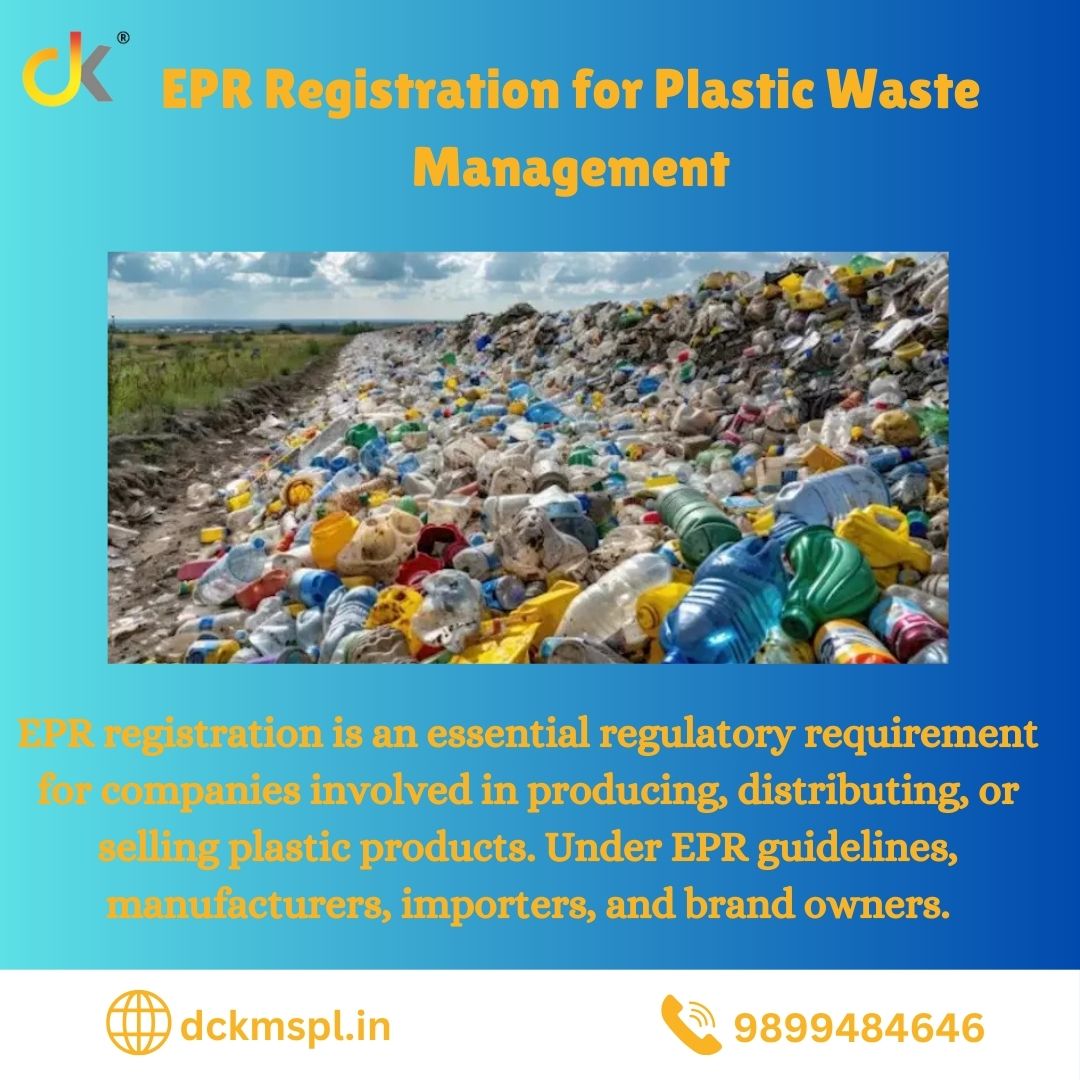In recent years, the issue of plastic waste has become a pressing environmental challenge. Single-use plastics and packaging materials contribute significantly to pollution, affecting ecosystems, wildlife, and human health. To combat this growing problem, governments worldwide have introduced Extended Producer Responsibility (EPR) for plastic waste management, a framework that holds producers accountable for the entire lifecycle of their products. EPR registration is a crucial step in this process, creating a structured way for companies to manage plastic waste sustainably.
What is EPR and Why is it Important?
EPR registration for plastic waste management is a policy approach designed to make manufacturers responsible for their products even after the point of sale. Under EPR, companies producing, importing, or distributing plastic materials are tasked with ensuring that waste from these products is collected, recycled, or properly disposed of. By enforcing EPR, governments aim to reduce plastic pollution, increase recycling rates, and promote the reuse of materials in production.For plastic waste management, EPR encourages producers to rethink packaging designs, invest in recycling technologies, and support waste collection systems. This helps in reducing the environmental impact of plastic products and contributes to a circular economy.
Key Steps in EPR Registration
To comply with EPR requirements, companies must register with relevant authorities, usually through an online portal provided by the government. Here’s a breakdown of the main steps involved in EPR registration:
- Assess Product Impact and Waste Generation
The first step involves evaluating the types of plastic waste generated from products, including packaging and single-use items. Companies must understand the potential environmental impact of their products and plan accordingly. - Develop a Waste Collection Strategy
To meet EPR requirements, companies must set up or partner with waste collection networks. These networks gather used plastic items from consumers, ensuring that waste is redirected from landfills to recycling facilities. - Plan for Recycling and Disposal
Companies need a clear plan for handling collected plastics. This may involve setting up recycling units, working with third-party recyclers, or even developing eco-friendly packaging alternatives. By improving recycling practices, companies can help reduce plastic waste at the source.
Benefits of EPR for Plastic Waste Management
Implementing EPR for plastic waste management offers multiple benefits for both companies and the environment.
- Reduces Plastic Pollution
EPR aims to lower the amount of plastic that ends up in landfills, rivers, and oceans. By holding producers responsible, EPR encourages more efficient waste management systems that prevent plastic pollution at the source. - Encourages Sustainable Product Design
To meet EPR standards, companies may need to rethink the materials and design of their products. This could mean reducing plastic use, using biodegradable alternatives, or designing packaging that is easier to recycle. - Enhances Corporate Social Responsibility (CSR)
Companies that participate in EPR demonstrate a commitment to sustainability, boosting their corporate social responsibility profile. Consumers are increasingly supporting environmentally conscious brands, making EPR compliance a positive brand attribute.
Challenges of EPR Implementation
While EPR is beneficial, companies often face several challenges in implementing it effectively:
- High Initial Costs
Establishing collection, recycling, and reporting systems can be costly, especially for smaller companies. Many businesses may need to invest in new infrastructure or partner with third-party waste management firms to comply with EPR. - Logistical and Operational Complexities
Managing waste collection and recycling across diverse locations can be challenging, particularly for large companies. Ensuring consistent compliance across multiple regions requires robust management systems and efficient coordination. - Limited Recycling Infrastructure
In some areas, recycling facilities may be insufficient to handle large volumes of plastic waste. Companies may need to invest in developing or supporting recycling infrastructure, particularly in regions lacking robust waste management systems.
Future of EPR in Plastic Waste Management
As awareness about plastic pollution grows, more countries are adopting EPR frameworks. The future of EPR in plastic waste management looks promising, with new policies, incentives, and technological innovations expected to drive progress. Governments may offer tax benefits or subsidies to companies that comply with EPR standards, making it easier for businesses to adopt sustainable practices.Furthermore, advancements in recycling technology could lower costs and improve the efficiency of EPR systems.
Conclusion
EPR registration for plastic waste management is an essential strategy in combating plastic pollution. By placing responsibility on producers, EPR promotes more sustainable practices, from product design to waste disposal. Though challenges exist, the benefits—reduced pollution, enhanced corporate responsibility, and support for a circular economy—make EPR a critical component in creating a more sustainable world. Companies that invest in EPR not only comply with regulations but also contribute to environmental protection, aligning themselves with the values of eco-conscious consumers and a cleaner future.
Storite 2 Pack Moisture Proof Nylon Large Size Underbed Storage Bag For Clothes (54 x 46 x 28 cm) - Black, Rectangular
₹499.00 (as of 11 March, 2025 11:37 GMT +05:30 - More infoProduct prices and availability are accurate as of the date/time indicated and are subject to change. Any price and availability information displayed on [relevant Amazon Site(s), as applicable] at the time of purchase will apply to the purchase of this product.)Study Table Bed Table Premium Laptop Table/Foldable and Portable Wooden/Writing Desk for Office/Home/School~~ (COTTED~Black)
₹439.00 (as of 11 March, 2025 11:42 GMT +05:30 - More infoProduct prices and availability are accurate as of the date/time indicated and are subject to change. Any price and availability information displayed on [relevant Amazon Site(s), as applicable] at the time of purchase will apply to the purchase of this product.)BSB HOME 3D Printed 144 TC Microfiber Double Bedsheet with 2 King Size Pillow Covers (Maroon, White and Yellow Checks, 90X90 Inches)
₹196.00 (as of 11 March, 2025 11:37 GMT +05:30 - More infoProduct prices and availability are accurate as of the date/time indicated and are subject to change. Any price and availability information displayed on [relevant Amazon Site(s), as applicable] at the time of purchase will apply to the purchase of this product.)Bajaj DX-6 1000W Dry Iron with Advance Soleplate and Anti-bacterial German Coating Technology 【White】
₹499.00 (as of 11 March, 2025 11:37 GMT +05:30 - More infoProduct prices and availability are accurate as of the date/time indicated and are subject to change. Any price and availability information displayed on [relevant Amazon Site(s), as applicable] at the time of purchase will apply to the purchase of this product.)Puzzle Berry® Wooden Piggy Bank for Kids & Adults, Coin Box with Carved Design, Savings Box, Mini Bank, Donation Box, Smart Money Box, Wooden Coin Box, Money Saver, Piggy Bank with Numbers
₹399.00 (as of 11 March, 2025 11:37 GMT +05:30 - More infoProduct prices and availability are accurate as of the date/time indicated and are subject to change. Any price and availability information displayed on [relevant Amazon Site(s), as applicable] at the time of purchase will apply to the purchase of this product.)Discover more from The General Post
Subscribe to get the latest posts sent to your email.





